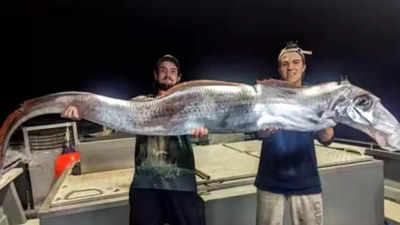
Recently, a rare oarfish, popularly known as the “doomsday fish” was caught off Melville Island in Australia’s Tiwi Islands, approximately about 80 kilometers from Darwin. Skipper Curtis Peterson of Tiwi Islands Adventures captured this astonishing creature while on a moonlight fishing trip. This stunning silver-coloured, ribbon-like-looking fish is known to grow up to over nine months long and is rarely seen by the human population, considering it is usually found in deep-sea habitats.
What makes Oarfish special?
These rare creatures are renowned for their serpent-like look and can swim at depths of up to 1,000 meters.Commonly, they are passive feeders, consuming small and krill sea creatures such as crabs, shellfish, prawns and lobsters. Encounters are uncommon as these fish are mostly found washed ashore, often dead. Peterson’s catch emphasizes a note-worthy event, as it is unusual to get a glimpse of such a magnificent creature alive in these waters.
The Doomsday fish legend
The nickname “doomsday fish” has manifested itself in several folklore traditions and tales, particularly in Japan, where doomsday is believed to herald disasters like tsunamis and earthquakes. One such event of sightings of oarfish is known to be reported before the damaging Tohoku earthquake in 2011. Although, many people connect these fish to upcoming calamities. Specialists such as Zachary Heiple from the Scripps Institution of Oceanography mention that there is no scientific evidence to back and prove these claims. He further explains “There’s this thought that they’re a doomsday fish or a bad omen… there didn’t really seem to be any correlation.”
Community reaction
The oarfish catch has gone viral and sparked a significantly lively response all around the internet, with over 1,300 comments on Fishing Australia TV’s Facebook post. Some skeptics speculated about the genuineness of the picture, with comments drawing a parallel between the fish and the magic sea dragon mentioning “Puff the magic sea dragon”, or giving it names such as “the fish version of the bloke at the pub who always has a wild story.”
In a nutshell, regardless of the formidable nickname, the oarfish remains a significantly intriguing example of mysterious marine life. Every sighting, whether connected to superstition or not, allures the imagination and showcases the hidden secrets that lie behind the ocean’s surface.
